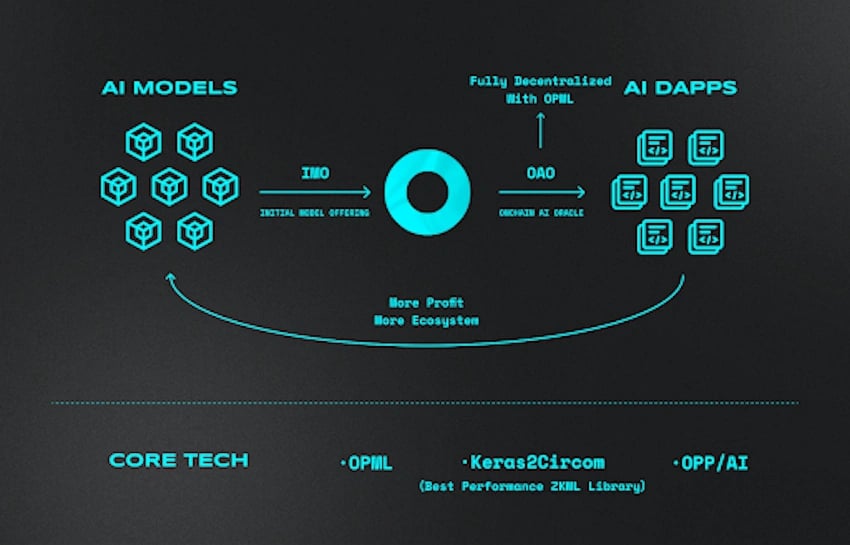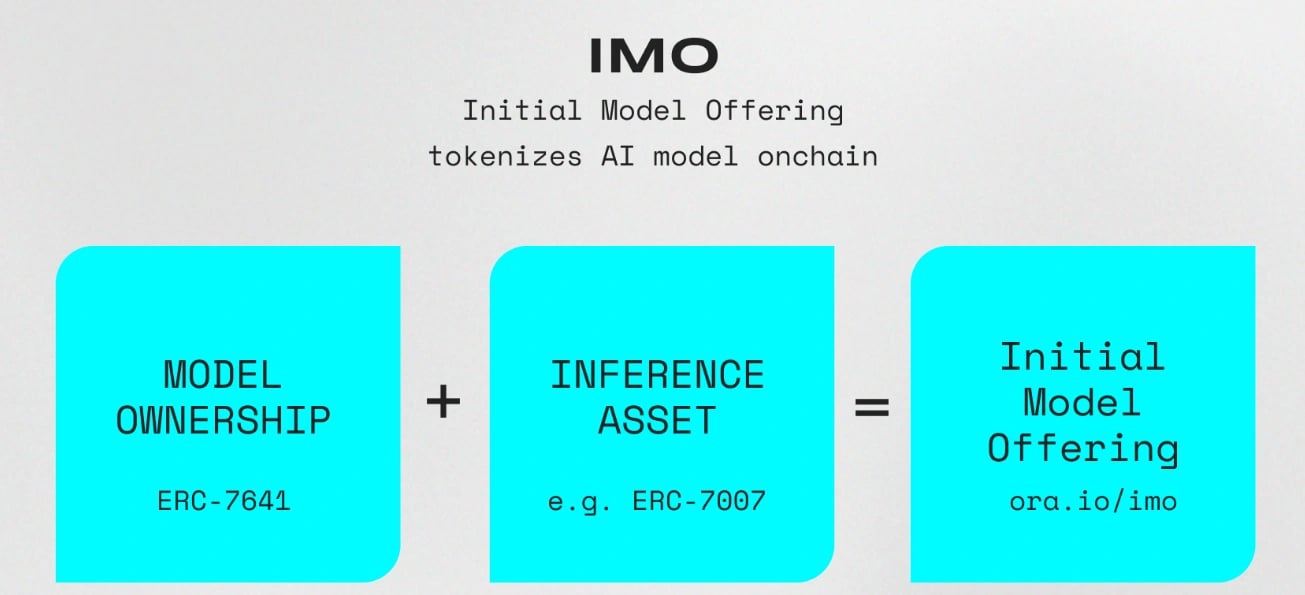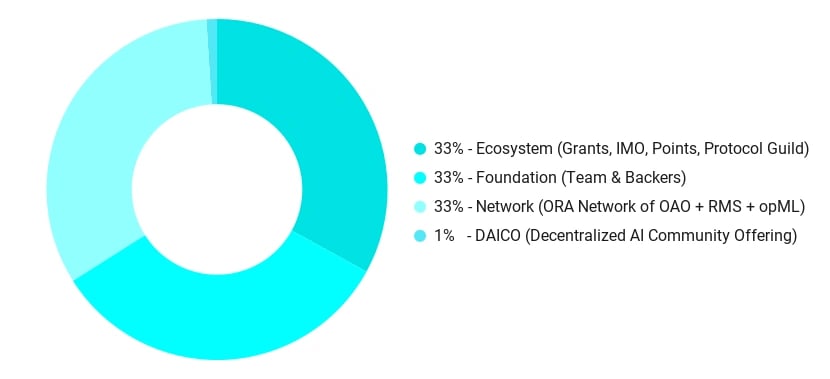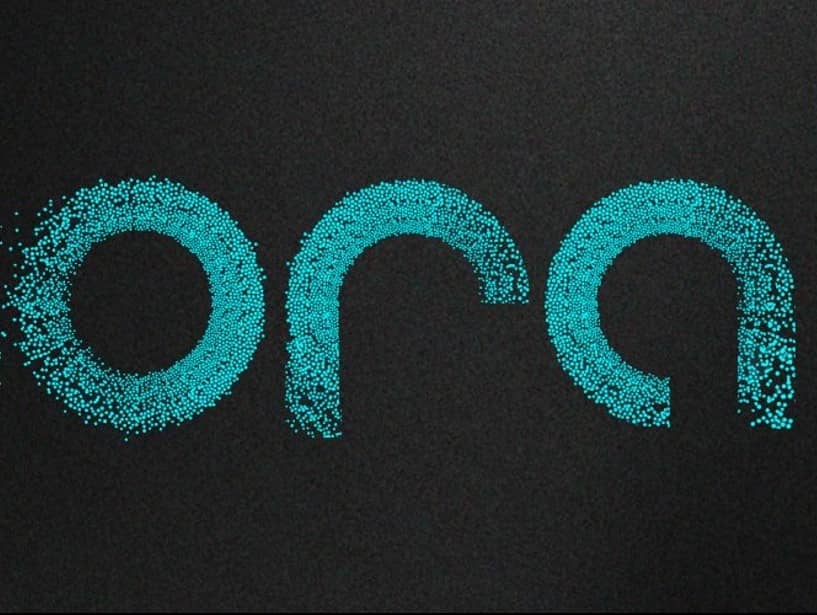ORA Protocol
**오라 프로토콜(Ora Protocol)**은 AI와 복잡한 컴퓨팅을 온체인으로 가져오는 검증 가능한 오라클 프로토콜입니다. 2022년 9월에 카르틴 웡(Kartin Wong)이 공동 설립했습니다. [1][2]
개요
오라 프로토콜(Ora Protocol)은 인공지능을 분산형 애플리케이션(Decentralized Applications, DApps)과 통합하기 위한 블록체인(blockchain)과 독립적인 인프라를 제공합니다. 개발자들이 AI 연산을 직접 온체인(on-chain)에서 실행하고 검증할 수 있는 도구를 제공하여 신뢰할 수 있고 분산된 시스템을 구축하는 것을 목표로 합니다. 이 프로토콜은 블록체인(blockchain) 환경 내에서 확장 가능하고 검증 가능한 AI를 가능하게 하는 데 중점을 둡니다. 주요 서비스인 AI 오라클(AI Oracle)을 통해 TORA 클라이언트를 사용하는 분산 노드(nodes) 네트워크를 통해 스마트 계약(smart contracts)이 AI 기능에 접근할 수 있습니다. 이 시스템은 연산 무결성을 보장하기 위해 낙관적 기계 학습(optimistic machine learning, opML)에 의해 지원됩니다. 오라(Ora)는 또한 ERC-7641을 사용하여 AI 모델을 토큰화하는 방법인 초기 모델 제공(Initial Model Offerings, IMOs)을 도입했습니다. 이러한 접근 방식은 오픈소스 AI 개발에 대한 자금 조달을 지원하고 이러한 모델을 분산형 애플리케이션(decentralized applications)에 사용하는 것과 관련된 토큰 보유자에게 수익을 배분합니다. [3]
제품
온체인 AI 오라클 (OAO)
오라 프로토콜의 온체인 AI 오라클은 머신러닝 추론을 블록체인에 가져오도록 설계된 검증 가능한 오라클 시스템입니다. 이를 통해 스마트 계약과 분산 애플리케이션은 LLaMA 3 및 Stable Diffusion과 같은 고급 AI 모델의 출력에 액세스하고 검증할 수 있습니다.
이 시스템은 사기 증명을 사용하여 계산을 검증하고 신뢰할 수 없는 실행을 보장하는 낙관적 머신러닝(opML)을 기반으로 합니다. 제로지식 머신러닝(zkML)과 비교하여 이 방법은 계산 비용을 줄이고 확장성을 향상시킵니다.
AI 오라클은 스마트 계약과 오프체인 구성 요소로 구성됩니다. _opML 계약_은 사기 증명과 검증 가능성을 관리하는 반면, _AIOracle 계약_은 오프체인 ML 노드와 온체인 호출자 간의 상호 작용을 용이하게 합니다. _사용자 계약_은 AI 요청을 보내고 결과를 받습니다. TORA 클라이언트를 실행하는 ORA 노드는 네트워크 전반에서 추론 결과를 제출하고 검증하는 역할을 합니다. [4]

낙관적 머신러닝 (opML)
opML(Optimistic Machine Learning)은 블록체인 네트워크에서 확장 가능하고 효율적인 머신러닝 추론을 가능하게 하는 프레임워크입니다. 이를 통해 고급 AI 모델이 블록체인을 과부하시키거나 중앙 집중식 시스템에 의존하지 않고 분산 환경에서 작동할 수 있습니다. 낙관적 롤업에서 영감을 받은 opML은 ML 계산이 도전받지 않는 한 유효하다고 가정하여, 즉각적인 온체인 검증의 필요성을 크게 줄이고 복잡한 AI 애플리케이션을 온체인에서 더 실용적으로 만듭니다.
이 시스템은 ML 작업의 오프체인 실행을 통해 효율성을 달성하며, 분쟁이 있는 결과만 온체인 검증을 거칩니다. 이는 사기 증명 메커니즘을 통해 수행됩니다. 결과는 서비스 제공업체가 제출하고, 검증자는 이를 도전할 수 있는 기간이 설정되어 있습니다. 분쟁이 발생하면 시스템은 정확한 계산 단계를 식별하고 사기 증명 가상 머신(FPVM)을 사용하여 해당 단계만 검증합니다. 이 방법은 계산 자원을 보존하면서 정확성과 무결성을 보장합니다.
제로지식 머신러닝(zkML)과 비교하여 opML은 증명 생성의 높은 비용을 피하여 분산형 AI에 대한 더욱 접근 가능한 솔루션을 제공합니다. 중앙 집중식 감독 없이 검증을 개방적이고 검증 가능하게 유지하여 분산화를 지원합니다. opML은 ORA의 AI 오라클을 통해 제공되므로 개발자는 안정적이고 비용 효율적인 AI 기능을 스마트 계약 및 블록체인 애플리케이션에 직접 통합할 수 있는 인프라를 제공합니다. [16]
낙관적 개인정보보호 AI
opp/ai(Optimistic Privacy-Preserving AI)는 제로지식 머신러닝(zkML)과 낙관적 머신러닝(opML)이라는 두 가지 기존 접근 방식의 기능을 결합하여 온체인 머신러닝에서 프라이버시와 효율성을 모두 지원하도록 설계된 프레임워크입니다. 데이터 기밀성이 필요한 계산에는 zkML을, 속도와 비용 효율성이 더 중요한 덜 민감한 프로세스에는 opML을 사용하여 민감도에 따라 머신러닝 모델을 구성 요소로 나눌 수 있습니다.
이 시스템은 모델을 두 부분으로 분할하여 작동합니다. 첫 번째 부분인 M_zk는 민감한 데이터 또는 독점 알고리즘이 포함된 하위 모델로 구성되며, 제로지식 증명을 사용하여 이 데이터의 개인 정보가 보호되도록 처리됩니다. 두 번째 부분인 M_op는 개인 정보 보호가 문제되지 않는 하위 모델을 포함하며, 이의 정확성에 이의가 제기되지 않는 한 정확성을 가정하는 opML의 낙관적인 접근 방식을 사용하여 오프체인에서 실행됩니다. 이러한 구조를 통해 opp/ai는 전체 zkML 시스템에서 일반적으로 발생하는 계산 오버헤드를 줄일 수 있습니다.
실행 중에 zkML 하위 모델의 출력은 opML 하위 모델에 입력될 수 있으며, 그 반대의 경우도 가능하므로 통합된 워크플로우가 가능합니다. zkML 부분은 검증을 위해 제로지식 증명을 블록체인에 제출하는 반면, opML 부분은 결과 정확도를 확인하기 위해 질문-응답 모델에 의존합니다. 이러한 방법을 결합함으로써 opp/ai는 블록체인 네트워크에서 AI 모델의 유연하고 안전하며 효율적인 배포를 지원합니다. [17]
탄력적인 모델 서비스(RMS)
탄력적인 모델 서비스(RMS)는 다양한 블록체인 시나리오에서 안정적이고 안전한 머신러닝 연산을 지원하기 위해 개발된 AI 인프라입니다. ORA의 opML(Optimistic Machine Learning) 프레임워크를 기반으로 구축된 RMS는 AI 프로세스가 안정적이고, 내결함성이 있으며, 검증 가능하도록 합니다. RMS의 초기 단계에는 개발자가 분산되고 검증 가능한 환경 내에서 채팅 완성 및 이미지 생성과 같은 작업을 위해 일반적으로 사용되는 AI 모델에 액세스할 수 있도록 하는 ORA의 AI API가 포함됩니다.
RMS는 투명하게 온체인에서 작동할 수 있는 자율적인 AI 에이전트의 개발을 지원합니다. 이러한 에이전트는 온체인 검증을 통해 안전하게 작업을 실행할 수 있으므로 높은 수준의 신뢰와 투명성이 필요한 애플리케이션에 적합합니다. 또한 RMS는 탈중앙화 금융(DeFi) 프로토콜과 AI의 통합을 용이하게 하여 온체인 시스템 내에서 자동 거래, 위험 평가 및 AI 기반 금융 에이전트를 구현하기 위한 도구를 제공합니다.
Web3 게임 또한 반응형 게임 메커니즘, 캐릭터 상호 작용 및 실시간 의사 결정을 위한 AI를 가능하게 함으로써 RMS의 이점을 누립니다. AI 결과의 블록체인 기반 검증을 통해 RMS는 게임 플레이의 공정성과 투명성을 유지하는 데 도움이 됩니다. RMS의 기반인 opML은 모든 지원되는 사용 사례에서 투명성과 신뢰성을 유지하면서 확장 가능하고 효율적이며 분산된 AI 연산을 제공합니다. [18]
초기 모델 제공(IMO)

초기 모델 제공(IMO)은 AI 모델을 온체인에서 토큰화하여 오픈소스 개발을 지원하도록 설계된 메커니즘입니다. 이 방법은 현재 지배적인 클로즈소스 기업의 압력을 받고 있는 오픈소스 AI 커뮤니티 개발자들이 직면하는 재정적 지속 가능성 문제를 해결하고자 합니다. AI 모델을 토큰화된 자산으로 전환함으로써 IMO는 개발 및 사용이 더욱 투명하고, 협력적이며, 재정적으로 실행 가능한 시스템을 만듭니다.
IMO는 Intrinsic RevShare 토큰이라고 하는 ERC-7641 토큰을 발행하는데, 이는 AI 모델의 미래 가치에 대한 소유권을 나타냅니다. 이 토큰은 소지자에게 AI 모델이 추론 또는 콘텐츠 생성에 사용될 때 발생하는 사용료의 일부를 제공합니다. 이 구조는 개발자, 사용자 및 기여자 간의 인센티브를 일치시켜 각 그룹이 모델 생태계의 성장과 거버넌스에 참여할 수 있도록 합니다.
IMO 프로세스에는 모델의 토큰화, 온체인 사용을 통한 가치 창출, 그리고 토큰 보유자에게 발생하는 수수료 배포가 포함됩니다. 거버넌스 기능을 통해 토큰 보유자는 보조금 할당 및 향후 업데이트에 대한 투표와 같이 모델 개발 방향에 영향을 미칠 수 있으며, 이는 AI 모델 발전에 대한 커뮤니티 중심 접근 방식을 강화합니다. [5] [6]
IMO 메커니즘
초기 모델 제공(IMO, Initial Model Offering) 메커니즘은 검증 가능한 온체인 AI 모델과 ERC-7641 내재적 수익 공유 토큰이라는 두 가지 핵심 구성 요소를 중심으로 구축됩니다. 이 구조는 블록체인에서 AI 모델 사용이 표준화된 토큰 시스템을 통해 가치를 직접 생성하고 분배하는 자체 포함 경제적 루프를 만드는 것을 목표로 합니다.
- 검증 가능한 온체인 AI 모델은 사기 증명을 적용하여 기계 학습 계산을 효율적이고 확장 가능하게 검증하는 프레임워크인 opML을 통해 가능해집니다. 이러한 모델은 AI 추론을 온체인에서 실행하고 검증할 수 있는 인프라 역할을 하는 ORA의 AI 오라클을 통해 배포됩니다. 이러한 설정을 통해 모델의 출력이 스마트 계약과 같이 사용될 때마다 수익 획득을 유발할 수 있는 검증 가능한 상호 작용이 발생합니다.
- ERC-7641 토큰은 모델 사용을 토큰 기반 보상과 연결하여 이러한 수익 분배를 용이하게 합니다. AI 모델이 체인에서 사용될 때마다 수수료가 징수되어 토큰 보유자에게 비례적으로 분배됩니다. 또한, 모델이 로열티 또는 민팅 수수료(예: NFT)가 있는 콘텐츠를 생성하는 경우 ERC-7007과 같은 관련 표준을 사용하여 해당 수익을 분배할 수 있습니다. 이러한 설계는 AI 모델의 경제 생태계에서 지속 가능한 개발과 분산된 참여를 지원합니다. [5]
ERC-7641
ERC-7641은 ERC-20 토큰 표준의 확장으로, 내장된 수익 공유 메커니즘을 통합하여 토큰 보유자들이 지정된 스냅샷 간격에서의 토큰 잔액에 비례하는 공동 수익 풀의 지분을 청구할 수 있도록 합니다. 이는 프로젝트가 수익 스트림을 토큰화하고 참여자들에게 수익을 공정하게 분배할 수 있도록 하여 지속 가능한 자금 조달을 지원합니다. 또한, 이 표준에는 보유자가 풀의 가치에 대한 지분과 교환하여 토큰을 소각하는 소각 기능이 포함되어 있어, 공급을 줄이고 장기적인 참여를 유도하는 디플레이션 경제를 도입합니다. [19]
ERC-7007
ERC-7007은 ERC-721 NFT 표준의 확장으로, 이더리움 블록체인에서 AI 생성 콘텐츠를 나타내고 검증하도록 설계되었습니다. 이를 통해 NFT는 AI 생성 콘텐츠를 인증하여 특정 모델이 주어진 입력을 사용하여 생성되었음을 보장합니다. 이 표준은 콘텐츠의 정확성을 검증하기 위해 Zero-Knowledge 머신러닝(zkML) 및 Optimistic 머신러닝(opML)을 통합합니다. AI 생성 콘텐츠를 검증하고 수익화할 수 있는 방법을 제공함으로써, ERC-7007은 AI 모델 작성자와 콘텐츠 제작자를 지원하며, 검증 가능한 NFT를 통해 수익 공유를 가능하게 하는 안전하고 표준화된 방법을 제공합니다. 여기에는 AI 모델, zkML/opML 검증, 그리고 콘텐츠 및 검증 프로세스를 관리하는 호환 가능한 AIGC-NFT 스마트 계약 등의 구성 요소가 포함됩니다. [20]
ORA
$ORA 토큰(ORA 토큰)은 ORA 생태계의 핵심 요소이며 여러 기능을 제공합니다. $ORA 토큰은 초기 모델 제공(IMO, Initial Model Offerings)에 대한 접근 권한을 부여하여 회원들이 최첨단 오픈소스 AI 모델 개발에 자금을 지원할 수 있도록 합니다. 토큰 보유자는 $ORA를 스테이킹(Staking)하여 (https://iq.wiki/wiki/staking) OAO 및 RMS와 같은 서비스를 지원하는 분산형 노드(Nodes) (https://iq.wiki/wiki/node)를 운영하고 거래 수수료(Transaction Fees) (https://iq.wiki/wiki/transaction-fee)를 획득할 수 있습니다. 또한, $ORA는 분산형 거버넌스를 가능하게 하여 보유자들이 프로토콜의 방향에 영향을 미칠 수 있도록 합니다. 더불어, $ORA는 범용 가스(Gas) (https://iq.wiki/wiki/gas) 역할을 하여 $ORA를 해당 트랜잭션에 필요한 네이티브 가스(Gas) (https://iq.wiki/wiki/gas)로 변환함으로써 체인 및 프로토콜 간의 가스(Gas) (https://iq.wiki/wiki/gas) 없는 상호 작용을 가능하게 합니다. [21]
토큰 경제학

ORA는 총 3억 3333만 3333개의 토큰을 공급하며, 다음과 같이 분배됩니다. [21]
- 생태계: 33%
- 재단: 33%
- 네트워크: 33%
- DAICO: 1%
팀
- 카틴 웡 - 공동 창립자 & 생성기 [9]
- 알렉 제임스 - 생태계 성장 [10]
- 캐시 소 - 수석 과학자 [11]
- 슈샤오 미아오 - 소프트웨어 개발자 [13]
- 수닝 야오 - 연구 엔지니어 [12]
- 레비 슬레드 - 영지식 회로 엔지니어 [14]
파트너십
- 밈워(MemeWar)
- Hive (하이브)
- 테이스트 재단(Taste Foundation)
- 헤투 프로토콜(Hetu Protocol)
